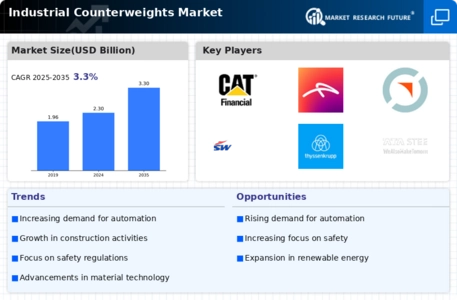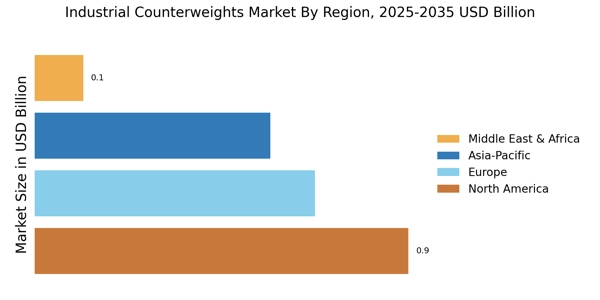Rising Demand for Heavy Machinery
The Industrial Counterweights Market is experiencing a notable increase in demand for heavy machinery across various sectors, including construction, mining, and manufacturing. As industries expand and modernize, the need for robust equipment that can handle substantial loads becomes paramount. This trend is reflected in the projected growth of the heavy machinery market, which is expected to reach USD 200 billion by 2026. Consequently, the demand for industrial counterweights, which enhance the stability and safety of such machinery, is likely to rise. The integration of counterweights in cranes, excavators, and forklifts is essential for operational efficiency, thereby driving the Industrial Counterweights Market forward.
Growth in Renewable Energy Projects
The Industrial Counterweights Market is poised to benefit from the surge in renewable energy projects, particularly in wind and solar energy sectors. As the world shifts towards sustainable energy solutions, the installation of wind turbines and solar panels necessitates the use of heavy machinery equipped with counterweights for stability. The Industrial Counterweights Market is projected to grow at a CAGR of 8% from 2025 to 2030, indicating a robust demand for industrial counterweights. This growth is likely to create opportunities for manufacturers and suppliers within the Industrial Counterweights Market, as they cater to the specific needs of renewable energy applications.
Expansion of Construction Activities
The Industrial Counterweights Market is benefiting from the expansion of construction activities worldwide. Urbanization and infrastructure development projects are driving the demand for construction equipment, which often requires counterweights for stability and safety. The construction sector is projected to grow at a CAGR of 5% through 2030, indicating a robust market for industrial counterweights. As construction companies invest in modern machinery to enhance productivity, the need for effective counterweight solutions becomes increasingly critical. This trend is likely to propel the Industrial Counterweights Market, as manufacturers respond to the growing requirements of the construction sector.
Increased Focus on Safety Regulations
The Industrial Counterweights Market is significantly influenced by the heightened focus on safety regulations across various sectors. Governments and regulatory bodies are implementing stringent safety standards to minimize workplace accidents, particularly in industries that utilize heavy machinery. The incorporation of counterweights is a critical aspect of ensuring equipment stability and operator safety. As a result, companies are increasingly investing in industrial counterweights to comply with these regulations. The market for safety equipment, including counterweights, is expected to grow, reflecting the commitment of industries to prioritize safety. This trend is likely to bolster the Industrial Counterweights Market as manufacturers innovate to meet evolving safety standards.
Technological Innovations in Manufacturing
The Industrial Counterweights Market is witnessing a transformation driven by technological innovations in manufacturing processes. Advancements in materials science and production techniques are enabling the creation of lighter yet stronger counterweights, which enhance the performance of heavy machinery. The adoption of automation and smart manufacturing technologies is also streamlining production, reducing costs, and improving product quality. As industries increasingly seek efficient and effective solutions, the demand for technologically advanced counterweights is expected to rise. This trend not only supports the growth of the Industrial Counterweights Market but also encourages manufacturers to invest in research and development to stay competitive.


















Leave a Comment